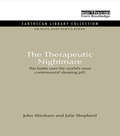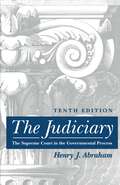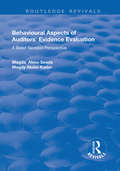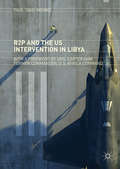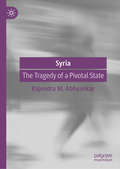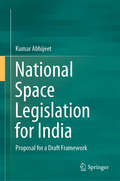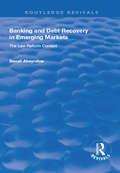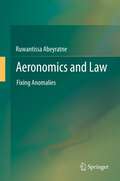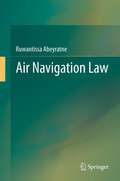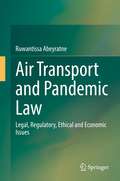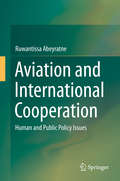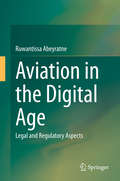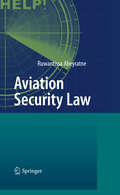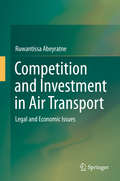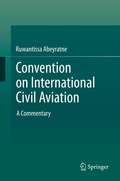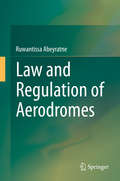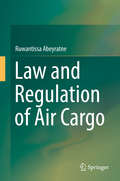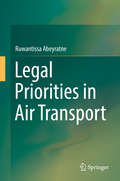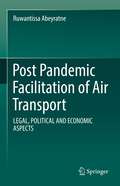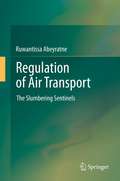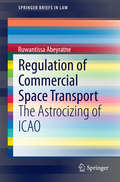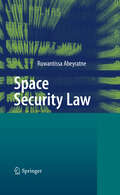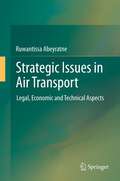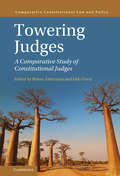- Table View
- List View
The Therapeutic Nightmare: The battle over the world's most controversial sleeping pill (Health And The Environment Ser.)
by John Abraham Julie SheppardHow do drugs get to the market? What controls are there and what procedures for monitoring their effects? And how adequate are the regulators in protecting public health when new drugs have serious side effects? The Therapeutic Nightmare tells the story of the sleeping pill Halcion - a story which is far from over. First marketed in the 1970s, Halcion has been taken by millions of patients around the world. For many years it has been associated with serious adverse effects such as amnesia, hallucinations, aggression and, in extreme cases, homicide. Thirteen years after its first release, it was banned by the British government. It remains on sale in the United States and many other countries. This book explains why patients have come to be exposed to Halcion's risks and examines the corporate interests of the manufacturers, the professional interests of the scientists and medical researchers and the interests of patients in safe and effective medication. It reveals how these contending forces shape the regulatory decision-making process about drug safety. As the number of new drugs and health products grows, a major challenge facing regulators and the medical profession is how to put the interests of public health decisively and consistently above the commercial interests of the drugs industry, while becoming more accountable to patient and consumer organizations.
The Judiciary: Tenth Edition
by Henry J. AbrahamRevised and updated to include the latest Supreme Court decisions, this classic text, now in its tenth edition, provides a concise overview of the judiciary in general and the Supreme Court in particular. The only book available that combines theory and practice of the judicial process with civil rights and liberties, The Judiciary acquaints students with the intricacies of our courts, the people who compose them, and their relationship to other branches of government, as well as to individuals and groups.
Behavioural Aspects of Auditors' Evidence Evaluation: A Belief Revision Perspective
by Magda Abou-Seada Magdy Abdel-KaderThis title was first published in 2003. Based on psychological research, auditing studies have focused on 'belief revision' as a way of understanding how auditors evaluate evidence. Moreover a belief revision process is consistent with US auditing standards. UK standards on the other hand do not appear to give guidance on the process to follow when evaluating evidence. Research in the US indicates that auditors do in fact follow a belief revision process in accordance with US standards. Employing survey research (based on personal interviews with a number of experienced UK auditors) this book demonstrates how auditors prefer to be described as following the open mind approach. Building on the findings of the interviews the book then describes an experimental study to investigate the differences between the belief revision and open mind approaches in terms of their effect on the efficiency and effectiveness of the audit process. The book concludes that the belief revision approach would improve the efficiency of the audit process without affecting its effectiveness or outcomes.
Public Assistance Volume 1: American Principles and Policies
by Edith AbottPUBLIC ASSISTANCE VOLUME I American Principles and Policies In Five Parts: With Select Documents
R2P and the US Intervention in Libya
by Paul Tang AbomoThis book argues that the Responsibility to Protect (R2P) the Libyan people played an important role in the U.S.’s decision to act, both in terms of how the language of deliberation was framed and the implementation of the actual intervention once all preventive means had been exhausted. While the initial ethos of the intervention followed international norms, the author argues that as the conflict continued to unfold, the Obama administration’s loss of focus and lack of political will for post-conflict resolution, as well as a wider lack of understanding of ever changing politics on the ground, resulted in Libya’s precipitation into chaos. By examining the cases of Rwanda and Darfur alongside the interventions in Kosovo, Iraq and Afghanistan, the book discusses how these cases influenced current decision-making with regards to foreign interventions and offers a triangular framework through which to understand R2P: responsibility to prevent, react and rebuild.
Syria: The Tragedy of a Pivotal State
by Rajendra M. AbhyankarThe book focuses, through multiple levels of international reality, on the pervasive and widespread effect of the Syrian civil war on the unravelling of established norms---both global or national--- which have determined international relations during the last seven decades. It postulates that since 2011, the Syrian situation has catalysed the breakdown of the international system based on the United Nations and the Bretton Woods institutions. The core international values fostered by that system now laid waste, among others, are sovereignty, non-interference, sanctity of UN Security Council approval for waging war, human rights, protection of civilian populations, and the right of people to choose their own governments/leaders. By making the UNSC powerless in providing humanitarian assistance or fostering cease-fire and peace-making it has called into question the principles which have been held immutable for seventy years. More importantly, these norms have been breached by their originators. The book takes a wider perspective melding together the civil war’s international, regional and national consequences to understand how and why this one event has radiated profound consequences for the international system.
National Space Legislation for India: Proposal for a Draft Framework
by Kumar AbhijeetThis book discusses the need for national space legislation in India in the wake of private stakeholders entering the field and the expansion of outer space activities. Highlighting India’s commitment to responsibly pursuing its outer space ambitions through rule of law, the book discusses the rationale behind national space legislation and addresses the requirements of both international and domestic law. In order to suggest draft framework national space legislation for India, it examines and compares the legislations of twenty major space-faring countries to identify the best practices. One of the few scientific studies in India that proposes draft framework legislation for space activities in India, this book summarizes the three main reasons why national space legislation is necessary – to fulfill international obligations, to address India’s specific requirements and to enable non-governmental entities to participate. A must read for anyone interested in international space law and India’s role and responsibility toward it, it is a valuable resource for academics, scientists, policymakers, industry executives, lawyers and students as well as amateur space enthusiasts.
Banking and Debt Recovery in Emerging Markets: The Law Reform Context (Routledge Revivals)
by Sonali AbeyratneThis title was first published in 2001. A developing country that is pursuing free market economic policies requires a modern commercial law infrastructure, which enables the emerging economy to have in place properly functioning credit and other financial systems which stimulate domestic and foreign investment. This book provides a comparative analysis of the law and practice of debt recovery in India, Sri Lanka and Malaysia, demonstrating that a suitable debt-recovery system for a developing economy requires not only good laws and judicial remedies, but also appropriate financial industry practices such as credit and loan supervision policies.
Aeronomics and Law: Fixing Anomalies
by Ruwantissa AbeyratneThis book embarks on a contemporary analysis of the interaction of economics and law relating to air transport, delving into the major issues that plague the industry. It shows how some of the thorny and frustrating issues could be approached sensibly. Among the issues discussed are the anomaly of exponential growth of air transport which makes airline profitability continue to be poor; the legislative impediments in most countries that preclude direct foreign investment in the industry; the confounding and muddled mess behind the economics of aircraft engine emissions; and the inexplicable reality that, although civil aviation is primarily meant to meet the needs of the people of the world, State regulators have upended the equation and given priority to national interests over the interests of the passenger. The book will be of interest to economists and lawyers alike who deal with air transport issues, and also to academics and students in the area of transportation as well as regulators and airlines.
Air Navigation Law
by Ruwantissa AbeyratneThe aviation community, in which the International Civil Aviation Organization (ICAO), the International Air Transport Association (IATA) and the Civil Air Navigation Services Organization (CANSO) play leading roles, is hard at work in bringing aviation into the 21st Century. In doing so, the United States and Europe have taken proactive steps forward in introducing modernization, particularly in moving towards more efficient air traffic management systems within NextGen and SESAR. Elsewhere, in the fields of personnel licensing, rules of the air, accident investigation and aeronautical charts and information, significant strides are being made in moving from mere regulation to implementation and assistance calculated to make all ICAO member States self sufficient in international civil aviation. However, these objectives can be achieved only if the aviation industry has a sustained understanding of the legal and regulatory principles applying to the various areas of air navigation. This book provides that discussion. Some of the subjects discussed in this book are: sovereignty in airspace; flight information and air defence identification zones; rules of the air; personnel licensing; meteorological services; operations of aircraft; air traffic services; accident and incident investigation; aerodromes; efficiency aspects of aviation and environmental protection; aeronautical charts and information; the carriage of dangerous goods; and NextGen and SESAR . Except for NextGen and SESAR, these subjects form the titles of the Annexes to the Chicago Convention that particularly involve the rights and liabilities of the key players involved in air navigation.
Air Transport and Pandemic Law: Legal, Regulatory, Ethical and Economic Issues
by Ruwantissa AbeyratneThe book discusses legal, ethical, economic and trade aspects of the Pandemic as it affects air transport. It commences with the chronology of the virus spread and examines the various facets of human existential perspectives affected by the pandemic. Following this background is an evaluation of the effect on trade and economics, as well as the legal and regulatory structure concerning communicable diseases applicable to air transport. There is also a detailed discussion on legal liabilities and responsibilities of the State, airlines, airports and public both collectively and individually in coping with the pandemic against the backdrop of public health and the law. The Conclusion contains various recommendations on proactive measures that could be taken to ensure the establishment of a credible and effective legal and regulatory system to combat future pandemics.
Aviation and International Cooperation: Human and Public Policy Issues
by Ruwantissa AbeyratneThis book addresses an essential gap in the regulatory regime, which provides legislation, statements and guidelines on airlines, airports, air navigation services providers and States in the field of aviation, but is notably lacking when it comes to the rights of the airline passenger, and the average citizen who is threatened by military air strikes. It addresses subjects such as international resolutions on human rights and other human rights conventions related to aviation that impact both air transport consumers and people on the ground who are threatened by air strikes through drone attacks; disabled and obese airline passengers; compensation for delayed carriage and the denial of carriage; noise and air pollution caused by aviation and their effects on human health and wellbeing; prevention of death or injury to passengers and attendant compensatory rights; risk management; relief flights; and racial profiling. These subjects are addressed against the backdrop of real case studies that include but are not limited to instances of drone attacks, and contentious flights in the year 2014 such as MH 370, MH 17 and QZ 8501.
Aviation in the Digital Age: Legal and Regulatory Aspects
by Ruwantissa AbeyratneAll of the topics discussed in this book – from sovereignty to cybercrime, and from drones to the identification of passengers & privacy – are profoundly affected by algorithms; so are air traffic services and aeronautical communications. All of these aviation-related aspects are addressed in a 75-year-old treaty called the Chicago Convention and its Annexes, which, as this book argues, needs to be reviewed with a focus on its relevance and applicability in connection with Moore’s Law, which posits that transistors in computer microchips double in speed, power and performance every two years, while the cost of computers is halved during the same period. Firstly, in terms of traditional territorial sovereignty, we have arrived at a point where there is a concept of data sovereignty and ownership that raises issues of privacy. Data transmission becomes ambivalent in terms of territorial sovereignty, and the Westphalian model may not be the perfect answer. Whether it be the manufacture of airplanes, the transfer of data on individuals, or the transmission of aeronautical and telecommunications information – all have to be carried out in accordance with the same fundamental principle: duty of care. Against the backdrop of the relevant provisions of the Chicago Convention and its Annexes, the detailed analysis presented here covers key areas such as: megatrends; AI and international law in the digital age; blockchain and aviation; drones; aviation and telecommunications; aviation and the Internet; cybersecurity; and digital identification of passengers & privacy. In turn, the book suggests how we can best manage this transition.
Aviation Security Law
by Ruwantissa AbeyratneThe law plays a significant role in ensuring aviation security. This book addresses new and emerging threats to civil aviation; evaluates security tools now in use such as the Public Key Directory, Advance Passenger Information, Passenger Name Record and Machine Readable travel documents in the context of their legal and regulatory background; and discusses applicable security treaties while providing an insight into the process of the security audits conducted by the International Civil Aviation Organization (ICAO). The book also examines issues of legal responsibility of States and individuals for terrorist acts of third parties against civil aviation and discusses from a legal perspective the latest liability Conventions adopted at ICAO. The Conclusion of the book provides an insight into the application oflegal principles through risk management.
Competition and Investment in Air Transport: Legal and Economic Issues
by Ruwantissa AbeyratneThis book addresses emerging legal and economic issues in competition and investment in air transport, against the backdrop of the role governments and airlines should play in avoiding protectionism and encouraging innovation and creativity. It evaluates current trends in air transport and the direction the industry is taking in the twenty first century. There are discussions on key aspects of air transport, such as safety assurance and environmental protection, as they are impacted by competition. The rapid evolution of aerospace transport and its effect on competition in air transport is also examined. A recurring theme of the book is the influence of creative destruction and disruptive innovation on air transport. This is addressed through an in-depth study of the contentious areas of law relating to the abuse of dominant positions and state aid, as reflected in the ongoing claim by the three largest US carriers against Gulf carriers such as Emirates Airlines, Etihad and Qatar Airways. The US carriers claim that Emirates and Etihad - which operate air services into the United States by virtue of an open-skies agreement between the US and The United Arab Emirates - are using generous subsidies given to them by their g overnments to illegally capture the "legitimate" market belonging to the US carriers. These issues are clarified in the book using analyses of competition law and investment law as they apply to air transport, free-trade-agreement analogies and an open-skies case study.
Convention on International Civil Aviation: A Commentary
by Ruwantissa AbeyratneThis book is both a repertory guide to the Convention on International Civil Aviation (Chicago Convention) as well as a legal analysis of the provisions of the treaty. It traces action taken by the ICAO Assembly and the Council in the implementation of the Convention from the first ICAO Assembly in 1947 until 2012. Above all, the book offers a commentary on the functional and moral fabric of the Chicago Convention, which is not only a multilateral legal instrument that sets out basic principles of air navigation and air transport, but also serves as a moral compass that brings the people of the world together. The teleological nature of the Chicago Convention is reflected from the outset - from its Preamble which sets the tone and philosophy of the Convention - that aviation builds friendship and understanding among all people, to its technical provisions that range from rules of the air to landing at airports and customs and immigration procedures. The book effectively demonstrates the Aristotelian principle - that rules make people good by forming habits in them. Standardization, or in other words, compliance, is the driver of the Convention that keeps aviation safe, regular, efficient and economical. To that end, this book traces and details the sustained relevance of the Chicago Convention and the efforts of ICAO and the international aviation community towards keeping air transport on track and ready for its future exponential growth, both in letter and in spirit.
Law and Regulation of Aerodromes
by Ruwantissa AbeyratneThis book encapsulates in detail the principles pertaining to legal and regulatory aspects of aerodromes. As the title denotes, it discusses the various aspects of the structure and functioning of an aerodrome and the complexities involved. It focuses on the law and regulation of aerodrome certification and planning, aerodrome services, financial and economic planning, security, management and governance. The airport industry is one of the fastest growing within the aviation industry, requiring innovation and creativity in management. This in turn has called for an increased focus on advanced management programmes for airport managers and lawyers. The Airport Management Professional Accreditation Programme (AMPAP) offered worldwide by the International Civil Aviation Organization and Airports Council International, and the Angkasa Pura II Airport Management Excellence Programme of Indonesia are two such initiatives which give airport professionals a sound grounding on the principles and techniques of management and law.
Law and Regulation of Air Cargo
by Ruwantissa AbeyratneThis book explores the legal and regulatory aspects of the complex air cargo sector, discussing in detail the general principles of the carriage of air cargo; artificial intelligence and air cargo; facilitation; carriage of hazardous goods; human remains; and animals, as well as cargo security; price fixing and anti competitive conduct in air cargo operations; liability issues; the air cargo supply chain and contract of carriage. It also discusses related achievements of the International Civil Aviation Organization; the International Air Transport Association and Airports Council International. The value of goods carried by airlines represents 7.4% of the global Gross Domestic Product. While cargo carried by air accounts for less than 1% of global cargo carriage, airlines carry 35% of the value of world trade, making this industry highly valuable and efficient, and the most reliable way to transport goods throughout the world. On average, airlines transport 52 million metric tons of goods per annum, worth an equivalent of $6.8 trillion, i.e. $18.6 billion worth of goods daily.
Legal Priorities in Air Transport
by Ruwantissa AbeyratneAgainst the backdrop of enormous technological strides, this book argues that the air transport industry must be constantly vigilant in its efforts to employ a legal regime that is applicable to the aeronautical and human aspects of the carriage by air of persons and goods. In this regard, safety and security are of the utmost importance, both in terms of safe air navigation and the preservation of human life. Although the International Civil Aviation Organization (ICAO) addresses legal issues through its Legal Committee, many emerging issues that urgently require attention lie outside the Committee’s purview. This book analyzes in detail the items being considered by ICAO’s Legal Committee, considers the legal nature of ICAO, and discusses whether or not ICAO’s scope should be extended. Since the limited issues currently addressed by ICAO do not reflect the rapidly changing realities of air transport, the book also covers a broad range of key issues outside the parameters set by ICAO, such as: the need to teach air law to a new generation of aviation professionals; combating cyber-crime and cyber-terrorism; the regulation of artificial intelligence; traveller identification; interference with air navigation; human trafficking; unruly passengers; climate change; air carrier liability for passenger death or injury; Remotely Piloted Aircraft Systems (drones); and the cabin crew and their legal implications.
Post Pandemic Facilitation of Air Transport: LEGAL, POLITICAL AND ECONOMIC ASPECTS
by Ruwantissa AbeyratneFrom early 2020 for a period of two years at the end of which this book was written, air transport suffered unprecedented setbacks due to the COVID-19 pandemic. Although the pandemic may eventually fizzle out into another flu like occurrence, the restraint with which air transport services were offered would remain with us for a while with some practices being sustained, particularly those pertaining to public health. One of the main areas of air transport that was and will be affected significantly by the changed circumstances - is facilitation – a subject that is regulated by the Chicago Convention of 1944 and its Annex 9. This book looks in depth at the Annex as it will be applied in a post pandemic world, against its legal, socio-political, and economic impacts, addressing the Standards of the Annex on clearance of aircraft; entry and departure of passengers; and the carriage of cargo. It also discusses some critical aviation events in 2020 and 2021 that occurred as they relate to facilitation of air transport. Some of the key areas discussed are the role of ICAO; issues of public health as they relate to air transport; security of travel documents; smuggling of persons; digital technology and rights of the passenger; unruly passengers; carriage of disabled passengers; relief flights and repatriation flights; and facilities at airports.
Regulation of Air Transport
by Ruwantissa AbeyratneEvery ten years ICAO holds a worldwide air transport conference. The most recent such event - the 6th Worldwide Air Transport Conference (ATConf/6) - was held in Montreal from 18 to 22 March 2013. The questions posed by this book are: are the "clerical and administrative tasks" for ICAO which were decided on by ATConf/6 (and other preceding conferences) sufficient to meet the needs of the people of the world for safe, regular, economical and efficient air transport? Should ICAO not think outside of its 67-year-old box and become a beacon to air transport regulators? In other words, shouldn't the bottom line of ICAO's meaning and purpose in the field of air transport be to analyze trends and guide the air transport industry instead of continuing to merely act as a forum for global practitioners to gather and update information on their respective countries' policies for air transport? Shouldn't ICAO provide direction, as do other agencies of the United Nations? This book addresses ICAO's inability, unlike most other specialized agencies in their missions, to make a tangible difference in air transport development, through a discussion of key issues affecting the air transport industry. It also inquires into the future of air transport regulation.
Regulation of Commercial Space Transport
by Ruwantissa AbeyratneThis book provides a look at the various nuances of the commercial aspects of space transport and offers a workable and practical legal and regulatory approach to be taken by the International Civil Aviation Organization. The book also addresses the perceived lack of wisdom in neglecting to consider the basic legal structure of a regulatory regime for commercial space transport as a first step and goes on to analyze ways and means of using the existing legal instruments pertaining to international civil aviation as an analogous system that can be moulded into a separate and cohesive set of multilateral legal instruments that could apply to commercial space transport. As expected, commercial space transport has taken off with a flourish. It is now evident that, from sub-orbital flights to mining asteroids, this industry will grow exponentially. Signs of its importance are reflected by various international conferences being convened on the subject both by academia and the international community. The only snag is the lack of a regulatory instrument or in the least a contrived approach to a definitive legal regime that would provide a structure, purpose and direction to commercial space transport. This blatant lacuna and neglect has resulted in the emergence of various theories by academics and a half hearted look at the subject by the international legal community.
Space Security Law
by Ruwantissa AbeyratneAgainst the variegated background of bewilderment and cautious optimism that space transportation offers, this book begins with an exposé on international politics, the principles of which, bear upon space transportation, as well as the closeness of air space and outer space, and activities that straddle both frontiers at the same time. It discusses current issues and possibilities of communications and transportation in outer space, as well as the liabilities and accountability of the key players of space exploration.
Strategic Issues in Air Transport: Legal, Economic and Technical Aspects
by Ruwantissa AbeyratneThere are broadly four strategic issues in aviation: safety; security; environmental protection; and sustainability in air transport. These issues will remain for a long time as key considerations in the safe, regular, efficient and economic development of air transport. Within these four broad categories come numerous subjects that require attention of the aviation industry as well as the States. In six chapters, this book engages in detailed discussions on these subjects as they unravelled in events of recent years. The issue of safety is addressed first, following an introduction of the regulatory regime covering the four issues. Within the area of safety, the book covers such areas as safety management systems, safety and aeromedicine, safety and meteorology, the use of airspace, unmanned aircraft systems and safety oversight audits. In the security area, subjects covered include cyber terrorism, the integrity of travel documents, full body scanners, civil unrest and aviation, the suppression of unlawful acts on board aircraft and the financing of terrorism. The chapter on the environment focuses mainly on climate change - particularly on carbon credits, market based measures, the carbon market and emissions trading schemes and their effect on air transport. Finally, the chapter on sustainability discusses in detail market access along with such issues as slot allocation, open skies, the use of alternative fuels as an economic measure and corporate foresight. The concluding chapter wraps up with a discussion on where air transport is headed.
Towering Judges: A Comparative Study of Constitutional Judges (Comparative Constitutional Law and Policy)
by Rehan Abeyratne Iddo PoratIn Towering Judges: A Comparative Study of Constitutional Judges, Iddo Porat and Rehan Abeyratne lead an exploration of a new topic in comparative constitutional law: towering judges. The volume examines the work of twenty judges from fifteen jurisdictions, each of whom stood out individually among their fellow judges and had a unique impact on the trajectory of constitutional law. The chapters ask: what makes a towering judge; what are the background conditions that foster or deter the rise of towering judges; whether towering judges, on balance, are positive or detrimental for constitutional systems; how towering judges differ from one jurisdiction to another; how political and historical developments relate to this phenomenon; and how it fits within global constitutionalism. The answers to these questions offer important insight into exactly how these judges were able to shine to an uncommon degree in a profession where individualism is not always looked on favorably.
